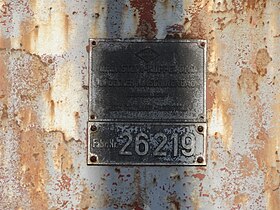O&K MV 3
| O&K MV 3 | |
|---|---|
|
Monument locomotive in Belgium
|
|
| Numbering: | various works tracks |
| Number: | 21st |
| Manufacturer: | OK |
| Year of construction (s): | 1961-1967 |
| Axis formula : | B. |
| Gauge : | 1435 mm ( standard gauge ) |
| Length over buffers: | 5,600 mm |
| Height: | 3,325 mm |
| Width: | 2,850 mm |
| Total wheelbase: | 2,540 mm |
| Smallest bef. Radius: | 50 m |
| Service mass: | 13 t |
| Friction mass: | 13 t |
| Wheel set mass : | 6.5 t |
| Top speed: | 15 km / h |
| Installed capacity: | 40.5 kW (55 PS) |
| Driving wheel diameter: | 850 mm |
| Motor type: | KHD A4L 514 |
| Motor type: | 4-cylinder four-stroke diesel engine |
| Rated speed: | 1,800 rpm |
| Power transmission: | hydraulic |
| Brake: |
Indirect brake type Knorr handbrake |
| Particularities: | air cooled |
The two-axle standard gauge - Diesel locomotives of the series O & K MV 3 with propeller shaft drive was designed for light shunting on industrial railways. They belong to the second post-war generation of O&K locomotives; Orenstein & Koppel built 21 examples from 1961 to 1967 . Some locomotives are still in use in 2020, others have been preserved as monuments.
development
After 1960 there was a need for diesel locomotives for the lower performance class for easy shunting on works railways. With MV is motor locomotive with power transmission through chain drive and 3 shown encrypts the engine power of about 60 hp. The locomotives were delivered to various large companies in Germany, one came to Italy , one to Switzerland and one to Morocco .
technology
The locomotives with the central driver's cab have a large front end for the machinery and a shorter rear front end stub. The stems are rounded, the machine front angled. In addition to the side access to the driver's cab, behind it there is a transition for the shunting personnel.
The diesel engine was originally an air-cooled four-cylinder four-stroke diesel engine from KHD . A mechanical gearbox with a multi-plate clutch is installed in the series, and a hydraulic power transmission is specified for the locomotive delivered to Johannes Nickel GmbH with the serial number 26219 .
All locomotives were equipped with a pulling and buffing device of the standard design. Some locomotives are equipped with indirect brakes of the Knorr type.
commitment
The locomotive, built in 1963 with the serial number 26219, was delivered to Johannes Nickel GmbH, Nidda-Oberwiddersheim. She provided the shunting in the company's operations in Dreihausen , the end point of the Marburger Kreisbahn . In 1972 the locomotive was moved to Marburg to operate a filling and loading facility. In 1998 it was transferred to the parent company of Nickel in Ober-Widdersheim . After the loading facilities were demolished, the locomotive was parked on a stump of track and was still there in 2018.
Pictures of the locomotive
Other missions
Some locomotives are still in use. Preserved locomotives, as memorials or on museum railways, are or were in Sprimont ( Belgium , 2011), in the Erkrath-Hochdahl Railway and Local History Museum , at the Phoenix Portland cement works in Beckum , Olfen (2013), at the Rheinisches Industriebahn-Museum , at the Bavarian Local Railway Association , at the Historisches Museum-Eisenbahn Mannheim , in the Scherrieble sand and gravel works in Weingarten and in Günther & Lochte GmbH Düsseldorf-Reisholz (whereabouts unknown since 2014).
literature
- Egbert Nolte: The Marburger Kreisbahn . Kenning Verlag, Nordhorn 1999, ISBN 3-933613-14-0 , pp. 64-66 .
Individual evidence
- ↑ Website about the 2nd generation O&K locomotives at www.rangierdiesel.de
- ↑ a b c Internet site about the O&K MV 3 locomotives at www.rangierdiesel.de
- ^ A b Egbert Nolte: The Marburger Kreisbahn . Kenning Verlag, Nordhorn 1999, ISBN 3-933613-14-0 , pp. 64-66 .
- ↑ Internet site about the O&K MV 3 locomotives from Nickel at www.rangierdiesel.de




